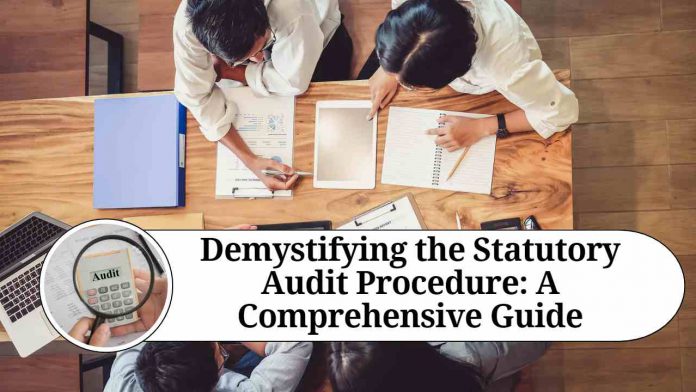Introduction:
In the realm of financial reporting and accountability, statutory audits hold immense significance. Conducted by independent, qualified professionals, these audits play a pivotal role in ensuring the accuracy, reliability, and transparency of financial statements. In this blog, we will dive into the statutory audit procedure, shedding light on its key components and providing an overview of the steps involved.
- Understanding Statutory Audit: A statutory audit is a legally mandated examination of an organization’s financial records, conducted to determine whether the financial statements fairly represent its financial position and performance. It ensures compliance with applicable laws, regulations, and accounting standards, thereby safeguarding the interests of stakeholders.
- Appointing an Auditor: The first step in the statutory audit process involves the appointment of an independent auditor. The auditor must possess the necessary qualifications, expertise, and independence to objectively assess the organization’s financial records.
- Planning the Audit: Before commencing the audit, the auditor plans the scope and objectives of the audit engagement. This involves gaining an understanding of the organization’s operations, identifying potential risks, and designing an audit strategy tailored to the specific circumstances.
- Conducting Risk Assessment: The auditor performs a comprehensive risk assessment, evaluating the internal control systems, identifying areas of potential material misstatements, and prioritizing audit procedures accordingly. This step ensures that the audit focuses on areas that carry higher risks.
- Audit Testing: In this stage, the auditor carries out substantive procedures, including analytical reviews, verification of account balances, transactions, and supporting documentation. These procedures help in gathering sufficient and appropriate audit evidence to support the financial statements’ assertions.
- Compliance and Regulatory Assessments: Apart from financial statement accuracy, statutory audits also involve assessing the organization’s compliance with legal and regulatory requirements. The auditor examines adherence to tax laws, company law provisions, and industry-specific regulations.
- Internal Control Evaluation: A critical aspect of the statutory audit is evaluating the organization’s internal control environment. The auditor assesses the design and effectiveness of internal controls to identify weaknesses, recommend improvements, and mitigate risks of fraud or errors.
- Audit Findings and Reporting: Upon completion of the audit procedures, the auditor summarizes the findings, including any material misstatements, control deficiencies, or non-compliance with regulations. These findings are documented in an audit report, which is shared with the organization’s management, board of directors, and shareholders.
- Follow-up Actions: After the audit report is issued, the organization’s management is responsible for taking necessary actions to address the auditor’s recommendations and rectify identified weaknesses. These actions may include implementing improved control procedures, revising accounting policies, or addressing compliance issues.
- Continuous Improvement: Statutory audits are not just a one-time event; they contribute to the organization’s overall financial health and governance. Organizations should use audit findings as an opportunity for continuous improvement, learning from past audits, and strengthening their financial reporting processes.
Conclusion
Statutory audits serve as a critical mechanism for maintaining trust, transparency, and accountability in financial reporting. By following a systematic and standardized audit procedure, auditors help safeguard the interests of stakeholders and provide valuable insights to organizations.
Understanding the various steps involved in a statutory audit allows organizations to appreciate the significance of this process and make informed decisions to enhance their financial management practices. Read Other Related Blogs: Square Off Share Market
Frequently Asked Questions (FAQs)
Q. What is a statutory audit?
A statutory audit is an independent examination of an organization’s financial records, conducted to ensure the accuracy and reliability of its financial statements. It is legally required in many jurisdictions and helps verify compliance with applicable laws, regulations, and accounting standards.
Q. Who conducts a statutory audit?
Statutory audits are conducted by independent external auditors who possess the necessary qualifications, such as being a certified public accountant (CPA) or a chartered accountant (CA). These auditors are typically appointed by the organization’s shareholders or regulatory authorities.
Q. What is the purpose of a statutory audit?
The primary purpose of a statutory audit is to provide an independent opinion on the fairness and reliability of an organization’s financial statements. It helps enhance transparency, improve financial reporting, and protect the interests of stakeholders, such as shareholders, creditors, and the general public.
Q. What are the key steps involved in a statutory audit procedure?
The statutory audit procedure typically involves several key steps, including appointing an auditor, planning the audit, conducting risk assessment, performing audit testing, assessing compliance and regulations, evaluating internal controls, reporting audit findings, and addressing any recommended improvements.
Q. What is the role of risk assessment in a statutory audit?
Risk assessment is a crucial step in the statutory audit process. It involves evaluating the organization’s internal control systems, identifying potential areas of material misstatements, and prioritizing audit procedures accordingly. This helps ensure that the audit focuses on areas with higher risks, increasing the effectiveness of the audit.
Q. What are substantive audit procedures?
Substantive audit procedures involve detailed examination and verification of account balances, transactions, and supporting documentation. These procedures help gather sufficient and appropriate audit evidence to support the financial statements’ assertions and detect any material misstatements.
Q. How does a statutory audit assess compliance with regulations?
A statutory audit evaluates an organization’s compliance with relevant laws, regulations, and accounting standards. The auditor examines adherence to tax laws, company law provisions, industry-specific regulations, and any other applicable legal requirements to ensure compliance and identify any potential violations.
Q. What happens after the statutory audit is completed?
Once the statutory audit procedures are completed, the auditor prepares an audit report summarizing the findings. This report is shared with the organization’s management, board of directors, and shareholders. The management is responsible for addressing any identified weaknesses or recommendations and taking appropriate actions to rectify them.
Q. Can a statutory audit help improve an organization’s financial management practices?
Yes, statutory audits offer valuable insights into an organization’s financial management practices. By identifying weaknesses in internal controls, suggesting improvements, and providing recommendations, statutory audits can help organizations enhance their financial reporting processes, governance, and overall financial health.
Q. Is a statutory audit a one-time event?
No, statutory audits are typically conducted annually or at specific intervals, as required by law or regulation. They are recurring processes that provide ongoing assurance to stakeholders regarding the accuracy, reliability, and compliance of an organization’s financial statements.




















